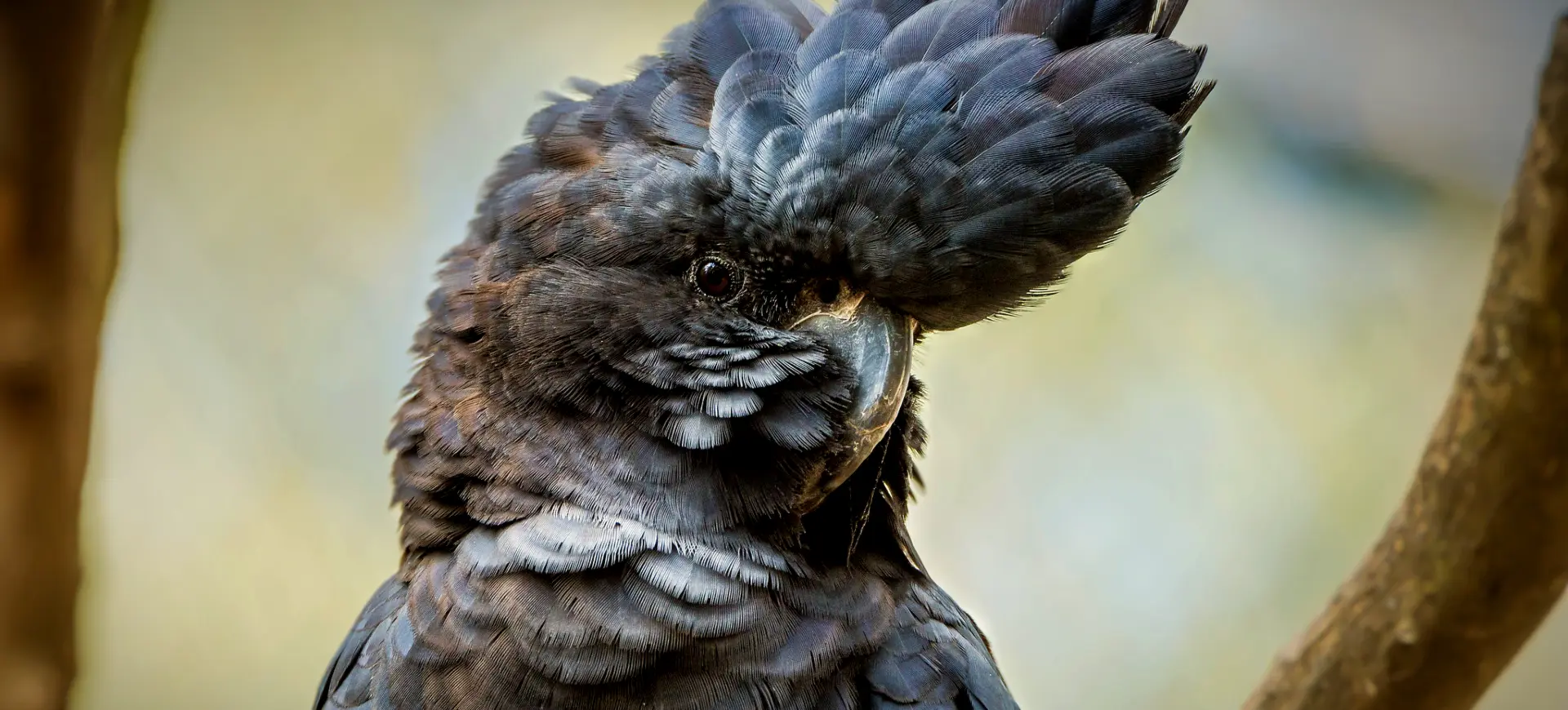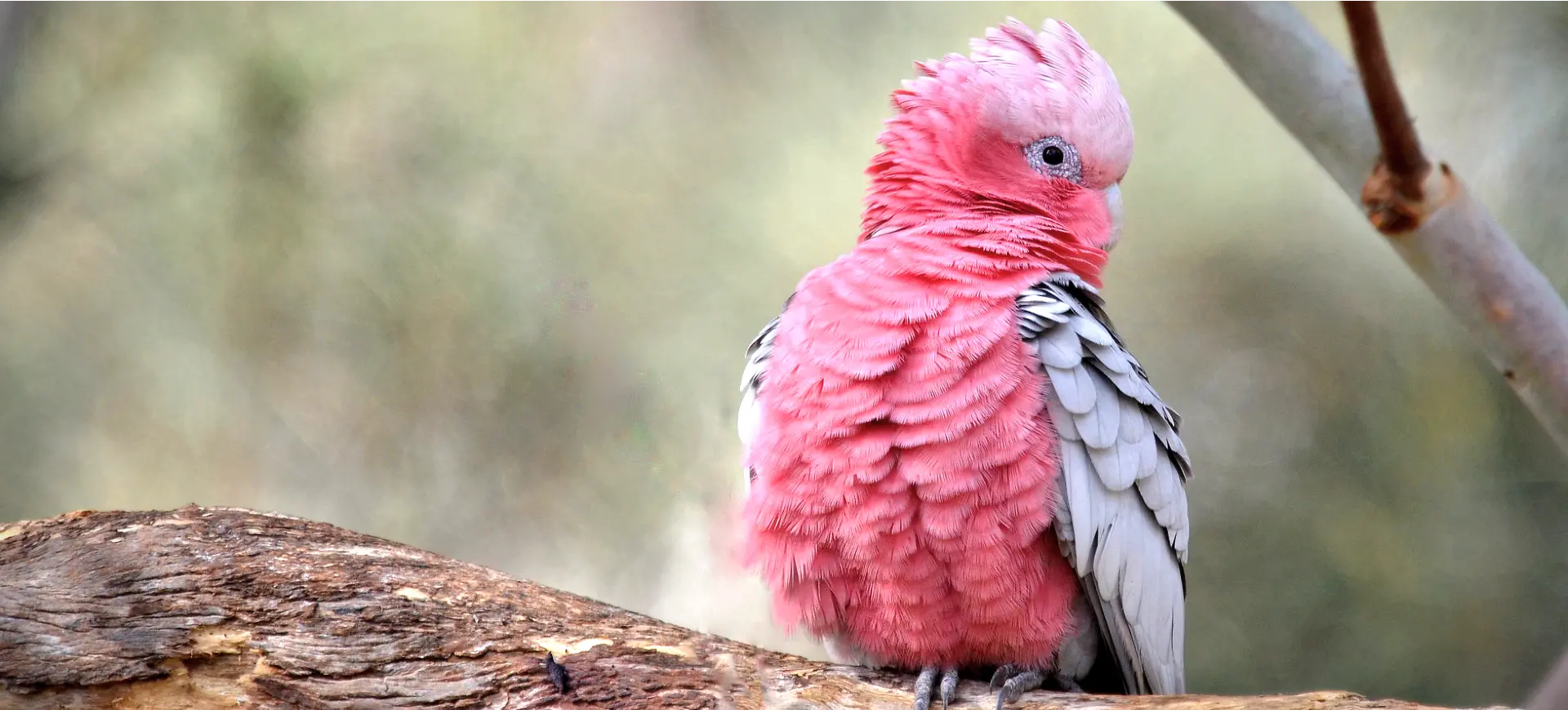Overview
The Palm Cockatoo, known for its striking appearance and intelligence, is a large black parrot native to the rainforests of New Guinea, Aru Islands, and parts of northern Queensland, Australia. It boasts a prominent crest of feathers on its head that can be raised or lowered at will, adding to its distinctive silhouette. This bird is notable for its size, which makes it one of the largest cockatoo species, and its robust bill is powerful enough to crack open hard nuts and seeds. The Palm Cockatoo uses its bill and a unique drumming behavior, where it beats sticks against trees to communicate and possibly attract a mate, highlighting its advanced cognitive abilities and complex social behavior.
The Palm Cockatoo has a deep black or smoky gray plumage, with a red cheek patch that changes color when the bird is excited or alarmed. Its large size, unique coloration, and crest make it one of the most striking and easily identifiable parrots in its habitat. The species plays a vital role in the ecosystem as a seed disperser, aiding in the regeneration of forest areas. Conservation efforts are in place to protect this magnificent bird, as habitat loss and pet trade pose significant threats to its population.
Despite its robust appearance, the Palm Cockatoo has a relatively low reproductive rate, laying a single egg every two to three years. This factor, combined with ongoing habitat destruction and illegal trapping for the bird trade, has led to concerns over its long-term viability in the wild. Efforts to understand and mitigate these threats are crucial for conserving the Palm Cockatoo, ensuring that future generations can continue to witness the beauty and complexity of this remarkable species.
Taxonomy
Kingdom
Phylum
Class
Order
Family
Genus
Species
Sub Species
Type
Physical Description:
The Palm Cockatoo is distinguished by its large frame, with adults reaching lengths of up to 24 inches from head to tail, making it one of the largest. Its plumage is predominantly a striking charcoal black or smoky gray, contrasting vividly with its red cheek patches. The bird’s powerful beak, one of the strongest among parrots, is well adapted for cracking open hard nuts and seeds, a key part of its diet. The expressive crest of feathers on its head can be raised or lowered to communicate its mood, adding to its dynamic appearance.
The Palm Cockatoo’s physical stature is complemented by its long wingspan, which aids in its ability to fly over the dense forests of its native habitat. Despite its heavy build, the Palm Cockatoo is an adept flier, capable of maneuvering through the trees with surprising agility. The red cheek patch, more pronounced in males, is a visual signal during social interactions and mating displays. The species exhibits slight sexual dimorphism, with males generally larger and having a broader bill than females.

Lifespan: Wild: ~60 years || Captivity: ~80 years

Weight: Male: 2.2-2.65 lbs (1-1.2 kg) || Female: 1.98-2.43 lbs (0.9-1.1 kg)

Length: Male: 22-24 inches (56-61 cm) || Female: 20-22 inches (51-56 cm)

Wingspan: Male & Female: 30-34 inches (76-86 cm)

Top Speed: 40 mph (64 km/h)
Characteristic:
Native Habitat:
The Palm Cockatoo inhabits the rainforests, woodland edges, and monsoon forests of New Guinea, Aru Islands, and Cape York Peninsula in northern Queensland, Australia. This species prefers large, contiguous areas of old-growth forest, which provide the necessary resources for feeding, nesting, and roosting. The complex structure of these habitats supports the Palm Cockatoo’s diverse diet and breeding requirements, including the availability of large tree hollows for nesting.
The Palm Cockatoo’s adaptability to different forest types within its range is critical for its survival, especially in areas affected by habitat fragmentation. Despite this adaptability, the species is sensitive to extensive deforestation and habitat degradation, threatening its long-term viability. Conservation of these habitats is essential for the Palm Cockatoo and the myriad other species that share its ecosystem. The Palm Cockatoo’s habitat preferences underscore the importance of protecting large tracts of old-growth forest as a cornerstone of biodiversity conservation strategies.
Climate Zones:
Biomes:
Biogeographical Realms:
Countries:
Diet:
Diet & Feeding Habits:
The Palm Cockatoo is an herbivore that eats various seeds, nuts, fruits, and berries in its rainforest habitat. It utilizes its strong beak to break open hard-shelled nuts, demonstrating a preference for native species such as the pandanus. This bird is also known to occasionally consume insects and their larvae, supplementing its diet with necessary proteins. The feeding behavior of the Palm Cockatoo plays a crucial role in seed dispersal, contributing to the health and diversity of its ecosystem.
In addition to its natural diet, the Palm Cockatoo has shown flexibility in foraging habits, often visiting areas with human activity to feed on introduced fruit trees. This adaptability, however, exposes the bird to potential risks from human-wildlife conflict and habitat alteration. The species’ dependence on large, intact tracts of forest for feeding and nesting highlights the importance of conserving its natural habitat. The Palm Cockatoo’s systematic approach to feeding, including using tools for nut-cracking, underscores its advanced cognitive abilities and problem-solving skills.
Mating Behavior:
Mating Description:
The Palm Cockatoo exhibits a unique and complex mating system characterized by monogamous pair bonds that can last for many years. During the breeding season, males perform elaborate displays to attract females, including drumming on hollow trees with sticks, a behavior not observed in any other parrot species. These displays, combined with vocalizations and the flashing of their cheek patches, play a crucial role in mate selection and bond formation. The species’ low reproductive rate, with usually only one egg laid per breeding attempt, underscores the importance of these complex behaviors in successful reproduction.
Nesting occurs in large tree hollows, which are in short supply and highly sought after, leading to competition among individuals. The female incubates the egg alone, while the male provides food and protection. The long dependency period of the chick, which remains in the nest for up to 110 days, necessitates a high level of parental investment from both parents. This extended care ensures the chick’s survival but also limits the number of breeding attempts the parents can make, impacting the overall reproductive output of the population.
Reproduction Season:
Birth Type:
Pregnancy Duration:
Female Name:
Male Name:
Baby Name:
Social Structure Description:
The Palm Cockatoo exhibits a complex social structure characterized by strong pair bonds and territorial behavior. Individuals or pairs maintain large territories, which they defend vigorously against intruders. The species is generally solitary or found in pairs, although small groups may gather at abundant food sources or communal roosting sites. Social interactions, including mutual preening and vocal communication, are key in maintaining pair bonds and social cohesion.
The Palm Cockatoo’s advanced cognitive abilities are evident in its social behavior, including using tools for communication and foraging. The species’ hierarchical social structure requires high social intelligence, allowing individuals to navigate complex social networks and maintain their social standing. Cooperation between mates in nesting and chick-rearing underscores the importance of social bonds in the species’ reproductive success. The social dynamics of the Palm Cockatoo, including its territoriality, pair bonding, and communal behaviors, are essential aspects of its ecology, influencing its habitat use, reproductive strategies, and interactions with other species.
Groups:
Conservation Status:
Population Trend:
The global population of the Palm Cockatoo is not precisely quantified but is believed to be declining due to habitat loss, deforestation, and the illegal pet trade. Despite its current classification as Least Concern by the IUCN, the species faces significant threats that could impact its long-term survival. In Australia, the Palm Cockatoo is listed as Vulnerable under national environmental legislation, reflecting concerns about its habitat and the pressures it faces from human activities. The species’ slow reproductive rate further complicates conservation efforts, limiting the population’s ability to recover from declines.
Conservation strategies for the Palm Cockatoo focus on protecting its habitat, regulating trade, and conducting research to better understand its ecological needs and population dynamics. Efforts to preserve large areas of old-growth forest are critical for maintaining the species’ habitat and supporting its complex life cycle. Community engagement and education play a key role in conservation, raising awareness of the Palm Cockatoo’s plight and the importance of protecting its environment. Ongoing monitoring and research are essential to track population trends and the effectiveness of conservation measures, ensuring that this iconic species can thrive in the wild for generations to come.
Population Threats:
Habitat loss due to deforestation for timber, agriculture, and urban development is the primary threat facing the Palm Cockatoo. The species relies on large tracts of old-growth forest, which are increasingly fragmented and degraded. The illegal pet trade also poses a significant risk, with the Palm Cockatoo’s striking appearance and rarity making it a coveted species among collectors. Climate change is an emerging threat, potentially impacting food availability and suitable nesting sites through weather patterns and forest composition changes.
Conservation efforts must address these threats through habitat protection, enforcement of trade regulations, and climate adaptation strategies. Public awareness and community involvement in conservation initiatives are crucial for protecting the Palm Cockatoo, highlighting the need for a holistic approach to conservation. Research into the species’ ecology and behavior can inform management decisions, ensuring that conservation strategies are effective and sustainable. International cooperation is essential, as the Palm Cockatoo’s range spans multiple countries, requiring coordinated efforts to ensure its survival.
Conservation Efforts:
Conservation efforts for the Palm Cockatoo include habitat protection, research, and regulation of the pet trade. Protected areas play a crucial role in conserving the species’ habitat, with national parks and reserves providing refuge from habitat loss and degradation. Research into the Palm Cockatoo’s ecology, behavior, and population dynamics informs conservation strategies, helping to identify critical habitat needs and threats. Regulation of the pet trade through CITES (the Convention on International Trade in Endangered Species of Wild Fauna and Flora) aims to prevent illegal capture and trade, protecting the species from overexploitation.
Community-based conservation initiatives engage local communities in protecting the Palm Cockatoo, fostering a sense of stewardship and providing economic alternatives to activities that harm the species. Rehabilitation and release programs for confiscated or injured birds contribute to population recovery efforts, although the species’ low reproductive rate limits the impact. Education and awareness campaigns raise public knowledge of the Palm Cockatoo’s plight, promoting support for conservation measures. Collaborative efforts between governments, NGOs, and local communities are essential for successfully conserving the Palm Cockatoo, ensuring a coordinated and effective response to its challenges.
Additional Resources:
Fun Facts
- The Palm Cockatoo is one of the few bird species known to use tools. It uses sticks to drum on trees as part of its mating display.
- Its powerful beak can exert pressure strong enough to crack open hard nuts and seeds, which are a staple of its diet.
- The red cheek patch of the Palm Cockatoo can change color when the bird is excited or stressed.
- They have one of the longest lifespans among parrots, living up to 60 years in the wild and even longer in captivity.
- Palm Cockatoos can mimic sounds and have a varied and complex vocal repertoire.
- The species has a very low reproductive rate, typically laying only one egg every two to three years.
- Palm Cockatoos are known to maintain large territories and defend against other cockatoos and predators.
- They play a significant role in their ecosystem as seed dispersers, aiding forest regeneration.
- The Palm Cockatoo’s crest of feathers can be raised or lowered to express its mood or intentions.
- Despite their size and powerful appearance, Palm Cockatoos are shy and elusive, often difficult to spot in the wild.







